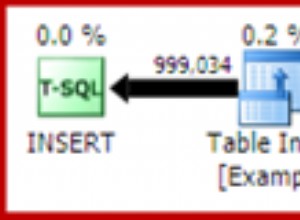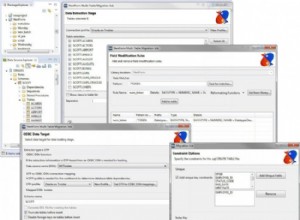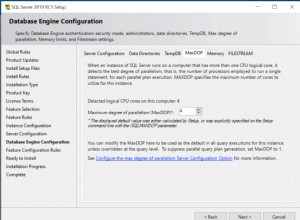DateTime di SQL Server ha il dominio 1753-01-01 00:00:00.000 ≤ x ≤ 9999-12-31 23:59:59.997. L'anno 210 d.C. è al di fuori di quel dominio. Da qui il problema.
Se stavi utilizzando SQL Server 2008 o versioni successive, puoi eseguirne il cast a un DateTime2 datatype e saresti d'oro (il suo dominio è 0001-01-01 00:00:00.0000000 &le x ≤ 9999-12-31 23:59:59.9999999. Ma con SQL Server 2005, sei praticamente SOL.
Questo è davvero un problema di pulizia dei dati. La mia inclinazione in casi come questo è caricare i dati di terze parti in una tabella di staging con ogni campo come stringhe di caratteri. Quindi ripulisci i dati in atto, sostituendo, ad esempio, le date non valide con NULL. Una volta pulito, esegui il lavoro di conversione necessario per spostarlo nella destinazione finale.
Un altro approccio consiste nell'utilizzare la corrispondenza dei modelli ed eseguire il filtraggio della data senza convertire nulla in datetime . I valori di data/ora ISO 8601 sono stringhe di caratteri che hanno la lodevole proprietà di essere (A) leggibili dall'uomo e (B) di essere raccolte e confrontate correttamente.
Quello che ho fatto in passato è un lavoro analitico per identificare tutti i modelli nel campo datetime sostituendo le cifre decimali con una 'd' e quindi eseguendo group by per calcolare i conteggi di ogni diverso pattern trovato. Una volta che lo hai, puoi creare alcune tabelle di schemi per guidarti. Qualcosa come questi:
create table #datePattern
(
pattern varchar(64) not null primary key clustered ,
monPos int not null ,
monLen int not null ,
dayPos int not null ,
dayLen int not null ,
yearPos int not null ,
yearLen int not null ,
)
insert #datePattern values ( '[0-9]/[0-9]/[0-9] %' ,1,1,3,1,5,1)
insert #datePattern values ( '[0-9]/[0-9]/[0-9][0-9] %' ,1,1,3,1,5,2)
insert #datePattern values ( '[0-9]/[0-9]/[0-9][0-9][0-9] %' ,1,1,3,1,5,3)
insert #datePattern values ( '[0-9]/[0-9]/[0-9][0-9][0-9][0-9] %' ,1,1,3,1,5,4)
insert #datePattern values ( '[0-9]/[0-9][0-9]/[0-9] %' ,1,1,3,2,6,1)
insert #datePattern values ( '[0-9]/[0-9][0-9]/[0-9][0-9] %' ,1,1,3,2,6,2)
insert #datePattern values ( '[0-9]/[0-9][0-9]/[0-9][0-9][0-9] %' ,1,1,3,2,6,3)
insert #datePattern values ( '[0-9]/[0-9][0-9]/[0-9][0-9][0-9][0-9] %' ,1,1,3,2,6,4)
insert #datePattern values ( '[0-9][0-9]/[0-9]/[0-9] %' ,1,2,4,1,6,1)
insert #datePattern values ( '[0-9][0-9]/[0-9]/[0-9][0-9] %' ,1,2,4,1,6,2)
insert #datePattern values ( '[0-9][0-9]/[0-9]/[0-9][0-9][0-9] %' ,1,2,4,1,6,3)
insert #datePattern values ( '[0-9][0-9]/[0-9]/[0-9][0-9][0-9][0-9] %' ,1,2,4,1,6,4)
insert #datePattern values ( '[0-9][0-9]/[0-9][0-9]/[0-9] %' ,1,2,4,2,7,1)
insert #datePattern values ( '[0-9][0-9]/[0-9][0-9]/[0-9][0-9] %' ,1,2,4,2,7,2)
insert #datePattern values ( '[0-9][0-9]/[0-9][0-9]/[0-9][0-9][0-9] %' ,1,2,4,2,7,3)
insert #datePattern values ( '[0-9][0-9]/[0-9][0-9]/[0-9][0-9][0-9][0-9] %' ,1,2,4,2,7,4)
create table #timePattern
(
pattern varchar(64) not null primary key clustered ,
hhPos int not null ,
hhLen int not null ,
mmPos int not null ,
mmLen int not null ,
ssPos int not null ,
ssLen int not null ,
)
insert #timePattern values ( '[0-9]:[0-9]:[0-9]' ,1,1,3,1,5,1 )
insert #timePattern values ( '[0-9]:[0-9]:[0-9][0-9]' ,1,1,3,1,5,2 )
insert #timePattern values ( '[0-9]:[0-9][0-9]:[0-9]' ,1,1,3,2,6,1 )
insert #timePattern values ( '[0-9]:[0-9][0-9]:[0-9][0-9]' ,1,1,3,2,6,2 )
insert #timePattern values ( '[0-9][0-9]:[0-9]:[0-9]' ,1,2,4,1,6,1 )
insert #timePattern values ( '[0-9][0-9]:[0-9]:[0-9][0-9]' ,1,2,4,1,6,2 )
insert #timePattern values ( '[0-9][0-9]:[0-9][0-9]:[0-9]' ,1,2,4,2,7,1 )
insert #timePattern values ( '[0-9][0-9]:[0-9][0-9]:[0-9][0-9]' ,1,2,4,2,7,2 )
Potresti combinare queste due tabelle in 1, ma il numero di combinazioni tende a far esplodere le cose, anche se semplifica notevolmente la query.
Una volta che hai questo, la query è [abbastanza] facile, dato che SQL non è esattamente la migliore scelta di linguaggio al mondo per l'elaborazione di stringhe:
---------------------------------------------------------------------
-- first, get your lower bound in ISO 8601 format yyyy-mm-dd hh:mm:ss
-- This will compare/collate properly
---------------------------------------------------------------------
declare @dtLowerBound varchar(255)
set @dtLowerBound = convert(varchar,dateadd(year,-1,current_timestamp),121)
-----------------------------------------------------------------
-- select rows with a start date more recent than the lower bound
-----------------------------------------------------------------
select isoDate = + right( '0000' + substring( t.startDate , coalesce(dt.yearPos,1) , coalesce(dt.YearLen,0) ) , 4 )
+ '-' + right( '00' + substring( t.startDate , coalesce(dt.monPos,1) , coalesce(dt.MonLen,0) ) , 2 )
+ '-' + right( '00' + substring( t.startDate , coalesce(dt.dayPos,1) , coalesce(dt.dayLen,0) ) , 2 )
+ case
when tm.pattern is not null then
' ' + right( '00' + substring(ltrim(rtrim( substring(t.startDate,dt.YearPos+dt.YearLen,1+len(t.startDate)-(dt.YearPos+dt.YearLen) ) ) ), tm.hhPos , tm.hhLen ) , 2 )
+ ':' + right( '00' + substring(ltrim(rtrim( substring(t.startDate,dt.YearPos+dt.YearLen,1+len(t.startDate)-(dt.YearPos+dt.YearLen) ) ) ), tm.mmPos , tm.mmLen ) , 2 )
+ ':' + right( '00' + substring(ltrim(rtrim( substring(t.startDate,dt.YearPos+dt.YearLen,1+len(t.startDate)-(dt.YearPos+dt.YearLen) ) ) ), tm.ssPos , tm.ssLen ) , 2 )
else ''
end
,*
from someTableWithBadData t
left join #datePattern dt on t.startDate like dt.pattern
left join #timePattern tm on ltrim(rtrim( substring(t.startDate,dt.YearPos+dt.YearLen,1+len(t.startDate)-(dt.YearPos+dt.YearLen) ) ) )
like tm.pattern
where @lowBound <= + right( '0000' + substring( t.startDate , coalesce(dt.yearPos,1) , coalesce(dt.YearLen,0) ) , 4 )
+ '-' + right( '00' + substring( t.startDate , coalesce(dt.monPos,1) , coalesce(dt.MonLen,0) ) , 2 )
+ '-' + right( '00' + substring( t.startDate , coalesce(dt.dayPos,1) , coalesce(dt.dayLen,0) ) , 2 )
+ case
when tm.pattern is not null then
' ' + right( '00' + substring(ltrim(rtrim( substring(t.startDate,dt.YearPos+dt.YearLen,1+len(t.startDate)-(dt.YearPos+dt.YearLen) ) ) ), tm.hhPos , tm.hhLen ) , 2 )
+ ':' + right( '00' + substring(ltrim(rtrim( substring(t.startDate,dt.YearPos+dt.YearLen,1+len(t.startDate)-(dt.YearPos+dt.YearLen) ) ) ), tm.mmPos , tm.mmLen ) , 2 )
+ ':' + right( '00' + substring(ltrim(rtrim( substring(t.startDate,dt.YearPos+dt.YearLen,1+len(t.startDate)-(dt.YearPos+dt.YearLen) ) ) ), tm.ssPos , tm.ssLen ) , 2 )
else ''
end
Come ho detto, SQL non è la scelta migliore per sgranocchiare stringhe.
Questo dovrebbe portarti ... il 90% lì. L'esperienza mi dice che troverai ancora più date sbagliate:mesi inferiori a 1 o maggiori di 12, giorni inferiori a 1 o maggiori di 31 o giorni fuori dall'intervallo per quel mese (niente come il 31 febbraio per far gemere il computer) , ecc. I vecchi programmi cobol in particolare, amavano usare un campo di tutti i 9 per indicare i dati mancanti, ad esempio (anche se questo è un caso facile da affrontare).
La mia tecnica preferita è scrivere uno script perl per ripulire i dati e caricarli in blocco in SQL Server, utilizzando le strutture BCP di perl. Questo è esattamente il tipo di spazio problematico per cui è progettato Perl.




